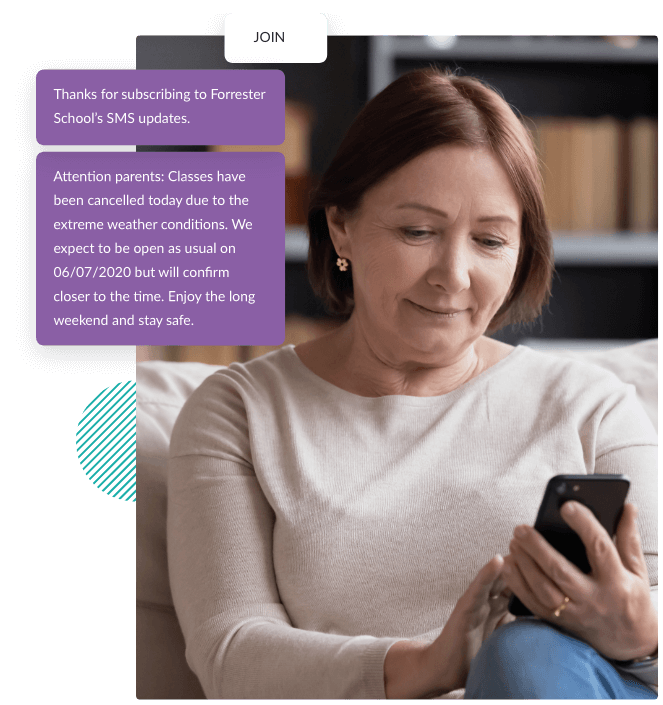SMS solutions for schools communication and higher education
Effective and automated communication for schools, colleges and universities
SMS streamlines schools communication, supports learning and saves time. Our SMS solutions for schools, colleges and universities help to keep parents, staff and students up-to-date with everything from event reminders to closure alerts so your organisation can run smoothly.

Trusted by leading education services brands to deliver powerful SMS schools communications
Education leaders need a direct line of communication with parents, staff and students to inform them of any disruptions like timetable changes, closures or to provide updates on sporting fixtures or pastoral care.
Our SMS solutions are fast and secure, and messages can be sent in bulk or to specific groups. With an open rate nearing 100% schools can maintain their duty of care by sharing important information about attendance, policies or school trips and prevent miscommunication by enabling two-way conversation.

Emergency notifications
Quickly notify parents and staff of an emergency by sending SMS to the whole school or to specific groups.

Build better relationships
Improve trust and communication with parents or guardians via an easy to access channel.

Boost student satisfaction
Create a safe space for students with feedback collected privately and efficiently through SMS surveys.

Communicate quickly and easily
When time is of the essence, Esendex enables you to quickly upload data to send messages immediately.
Delivery and read rates mean you can check if the message was received, and you have the option to choose from our library of message templates or build your own.
Save time and improve parent satisfaction
Empower parents or guardians to self-serve when it comes to tasks like booking parent-teacher appointments or paying for school lunches and trip fees – freeing up valuable time for your admin staff and teachers.
Parents will appreciate the convenience and staff can send automated SMS and devote their time to more value-add tasks.


Communicate using the channel of choice
SMS reaches staff and parents directly, and with an open rate of up to 98% you can be sure nothing is missed. SMS chat also enables two-way conversation enabling parents and staff to communicate easily, without having to make an appointment or phone call.
Along with SMS, Esendex supports email and WhatsApp so busy parents and guardians can receive information via their preferred channel.
Let’s start sending, together.
Discover the full power of our mobile messaging platform for schools, colleges and higher education.
Maintain security and compliance
The student data that you collect is highly sensitive – so it’s critical that it’s secure. The Esendex platform has security locked in with ISO27001 and FSQS accreditations and it’s compliant with GDPR. You can also include a sender ID to provide added reassurance and minimise fraud.

Meet your schools communication needs with one platform
With Esendex you can communicate through a number of channels via one platform and keep track of all your communication data.
No-reply SMS is ideal for holiday or meeting reminders, while SMS chat enables real-time two-way conversation. Our communication solutions are easy to implement and return value fast.
Customer success stories
Discover how Esendex’ financial customers solved their customer communication challenges with our mobile messaging platform:

Somerset County Council builds robust messaging backup system
Discover how Somerset County Council integrated Esendex into their existing Management Information System (MIS) to create an offsite backup system that enables emergency message sending should their MIS ever fail.

SMS Notifications: For emergencies and beyond
When budgets are tight, cheaper bulk SMS send rates may seem attractive – but businesses who use them can end up wasting time and money and damaging their brand in the process.

SMS templates for schools and higher education
From parents evening reminders to school closures, surveys and more, SMS is a great way to communicate with students and parents. Get started with these ready-to-use templates.
Let’s start sending, together.
Discover the full power of our mobile messaging platform.
